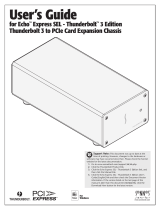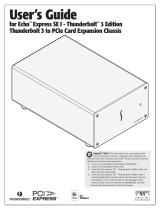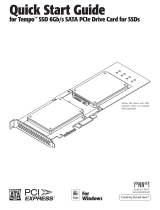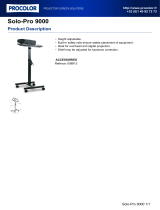Page is loading ...

Quick Start Guide
You Should Have
The following items should be included in your product package:
• One Solo10G PCIe Card
• One additional mounting bracket
• QSG
The following items may be required for installation:
• Medium Phillips screwdriver
Computer Compatibility
• Mac Pro
®
(Mid 2010 or newer), PC desktop or server with full-
height or low-profile PCIe slots
OS Compatibility
• macOS
®
10.13.6+ (macOS Mojave compatible)
• Windows
®
10, 8, 7; Server 2016, 2012, 2008
• Linux
®
Thunderbolt™ Compatibility
• Mac
®
or Windows computer with a Thunderbolt port via a
Thunderbolt-to-PCIe Card Expansion System
Driver Information
For Mac users, the drivers that enable the Solo10G PCIe Card to work
in your computer or Thunderbolt expansion chassis are installed as
part of macOS 10.13.6 and later; the Presto card is ready for use when
you power on your computer.
For Windows and Linux users, please go to www.sonnettech.com/
support/kb/kb.php, click the Computer Cards link, and then the PCIe
Cards link. Locate and click Solo10G PCIe Card link, and then click
the Driver link. Locate, download, and install the appropriate drivers.
Installation Preparation
Sonnet strongly recommends that you read the section in your
computer’s user manual that addresses PCIe card installation, prior to
installing the Sonnet card into your system.
Card Installation Steps
1. Shut down your computer or Thunderbolt-to-PCIe card
expansion system and disconnect it from its power source, and
then open it to access the expansion card area (PCIe slots); refer
to the user’s manual for specific information.
2. Locate an available x4 (4-lane) or larger PCI Express slot and
then remove its access cover.
3. Remove the Sonnet card from its packaging, and then install it
into the PCI Express slot; make sure the card is firmly seated
and secured.
4. Close your computer or expansion system, and then reconnect
it to its power source. If the card is installed in an expansion
system, also connect the Thunderbolt cable between the
Thunderbolt ports on the system and computer.
5. Connect a CAT 6A, CAT 6, or CAT 5e cable (depending on the
network connection) between the port on the Presto card and a
port on the switch or device.
* 10 Gb/s speed supported on CAT 6A and CAT 6 cabling at 100 and
55 meters, respectively. Lower speeds supported on CAT 5e (and
better) cabling at up to 100 meters. 5 Gb/s and 2.5 Gb/s link speed
support requires an NBASE-T (multi-Gigabit) compatible switch.
Solo
10
G
™
PCIe
®
Card
1-Port 10 Gigabit Ethernet PCIe 3.0 Card
©2018 Sonnet Technologies, Inc. All rights reserved. Sonnet, the Sonnet logotype, Simply Fast, the Simply Fast logotype, and Presto
are trademarks of Sonnet Technologies, Inc. Mac, the Mac logo, Mac Pro, and macOS are trademarks of Apple Inc., registered in the
United States and other countries. Thunderbolt and the Thunderbolt logo are trademarks of Intel Corporation in the U.S. and/or
other countries. Other product names are trademarks of their respective owners. Product specifications subject to change without
notice. QS-G10E-1X-E3-E-E-121018
Support Notes: When handling computer products, you
must take care to prevent components from being damaged
by static electricity. Before opening your computer or removing
parts from their packages, always ground yourself first by touching
a metal part of the computer, such as a port access cover, and work
in an area free of static electricity; avoid carpeted areas. Handle
all electronic components by their edges, and avoid touching
connector traces and component pins.
Support Note: This document was up to date at the time
of printing. However, changes to the hardware or software
may have occurred since then. Please check the Sonnet website for
the latest documentation.
1. Go to www.sonnettech.com/support/kb/kb.php
2. Click the Computer Cards link.
3. Click the PCIe Cards link.
4. Click the Solo10G PCIe Card link, and then click the
Documentation link.
5. Click the Solo10G PCIe Card Quick Start Guide [English] link, and
then check the Document Version information. If the version listed
is later than this document (revision E), click the Download Now
button for the latest version.

Basic Card Configuration Information—macOS
Configure the Solo10G card’s settings in the System Preferences
Network preferences panel; the card will be identified as a PCI
Ethernet card.
Performance Tuning Steps—macOS
Listed below are steps required to configure the Solo10G card for
maximum performance. Please note that to take advantage of these
settings, the switch or router to which the card is connected must
also support these features.
1. Open System Preferences, and then click Network. In the
Network System Preferences panel, click the Sonnet card’s port
in the left panel, and then click Advanced; a new panel appears.
2. In the Advanced panel, click Hardware. From the Configure
drop-down menu, select “Manually”. In the Speed drop-down
menu, leave the setting at, or select 10GbaseT (or 5000baseT or
2500baseT if either is the top speed your network connection
supports). In the Duplex drop-down menu, select “full-duplex”
(not “full duplex, flow-control”). In the MTU drop-down menu,
select “Custom,” and then select “Jumbo” or enter “9000” in
the box below.
3. When you’ve finished changing the settings, click OK.
4. Back in the main Network window, click Apply after you’ve
completed changing the settings.
5. If you used existing settings and do not need to combine
Ethernet ports (link aggregation), your installation is complete.
Basic Card Configuration Information—Windows
You may configure the Sonnet card’s settings using Windows Device
Manager. You may locate the device’s port in the Network adapters
category, listed as Presto Solo 10GBASE-T or Solo10G PCIe Card.
TIPS, GENERAL INFORMATION
5 Gb/s and 2.5 Gb/s Link Speed Support
The Solo10G PCIe Card supports 5 Gb/s and 2.5 Gb/s link speeds
when used with NBASE-T compatible (multi-Gigabit) switches, and
connected via CAT 5e (or better) cabling.
Audio Video Bridging (AVB) Support
The Solo10G PCIe Card supports AVB when used with AVB-
compatible (802.1Qav) switches.
Contacting Customer Service
The Sonnet Web site located at www.sonnettech.com has the
most current support information and technical updates. Before
contacting Customer Service, please check our Web site for the latest
updates and online support files, and check this Quick Start Guide
for helpful information.
Email support requests generally receive the fastest responses, and are
usually processed within a 24-hour period during normal business
hours, excluding holidays. When you contact Customer Service,
have the following information available so the customer service
staff can better assist you:
Product name • Date and place of purchase • Computer model
• OS version • A System Report (macOS) or a Microsoft System
Information MSINFO32 (Windows) report (Windows)
If further assistance is needed, please contact us at:
USA Customers
Please contact Sonnet Customer Service at:
E-mail: support@sonnettech.com
Tel: 1-949-472-2772
(Monday–Friday, 8 a.m.–4 p.m. Pacific Time)
For Customers Outside the USA
For support on this product, contact your reseller or local distributor.
Visit Our Web Site
For the most current product information and online support files,
visit the Sonnet web site at www.sonnettech.com. Remember to
register your product online at http://registration.sonnettech.com to
be informed of future upgrades and product releases.
Port and Indicator Information
1 – RJ45 (10GBASE-T) Port
Connect a CAT 6A, CAT 6 or CAT 5e*
cable between this port and the switch’s or
device’s RJ45 port.
2 – Link Speed Indicator
When a link is established between the
Solo10G card and the switch, this LED
lights to indicate the link speed to the
switch: green = 10Gb, yellow = 5Gb,
2.5Gb, 1Gb, and 100Mb.
3 – Link/Activity Indicator
This LED lights up green to indicate a link
is established between the Solo10G
card and the switch, and flashes
yellow when the link is training.
* 10 Gb/s speed supported on CAT-6A and
CAT 6 cabling at 100 and 55 meters,
respectively. Lower speeds supported on
CAT 5e (and better) cabling at distances up
to 100 meters.
/







